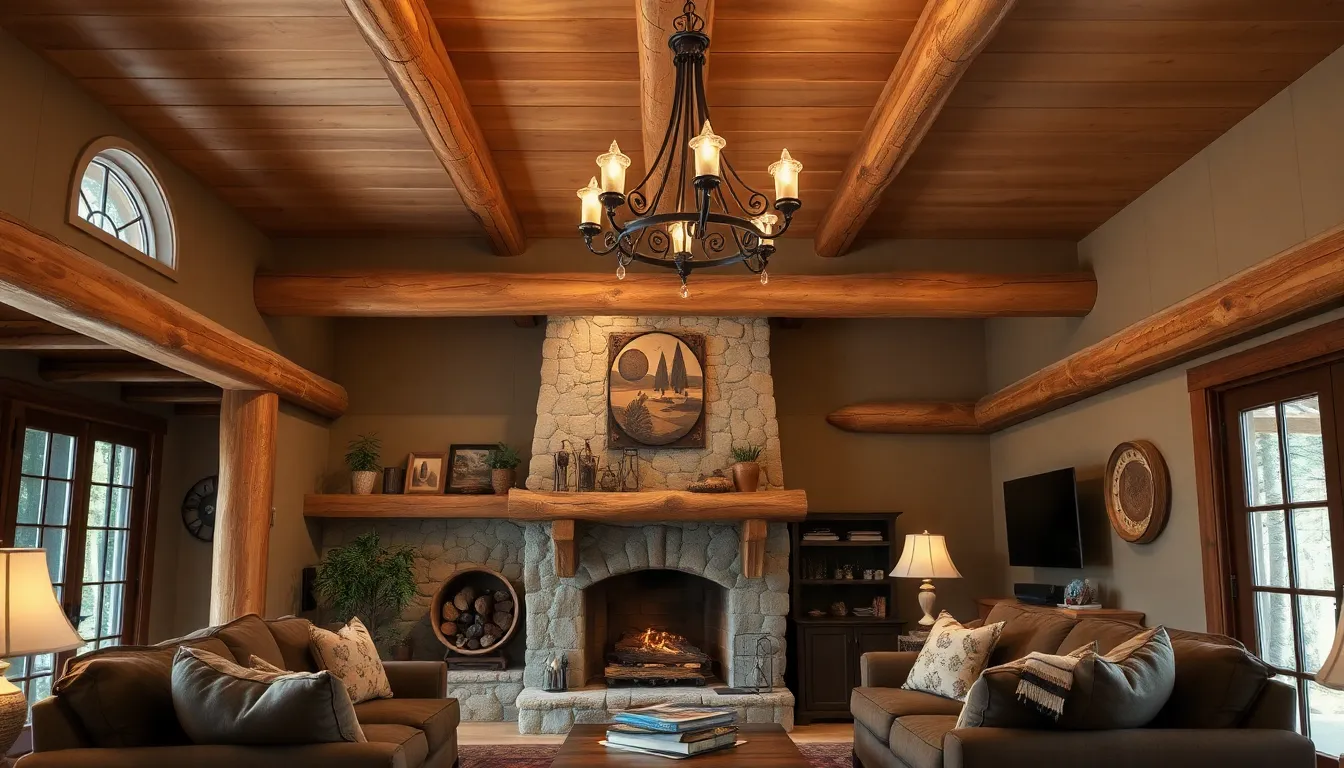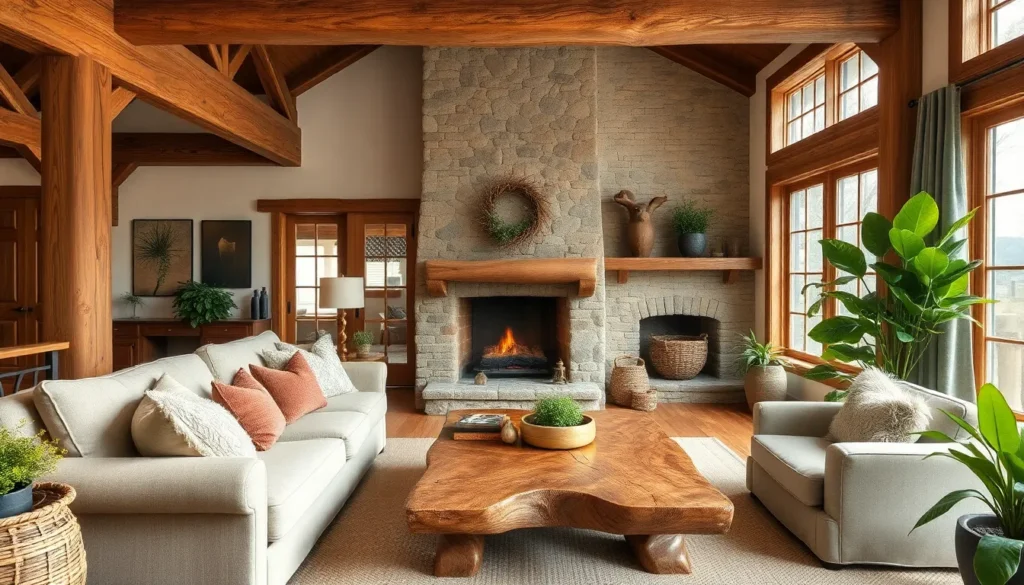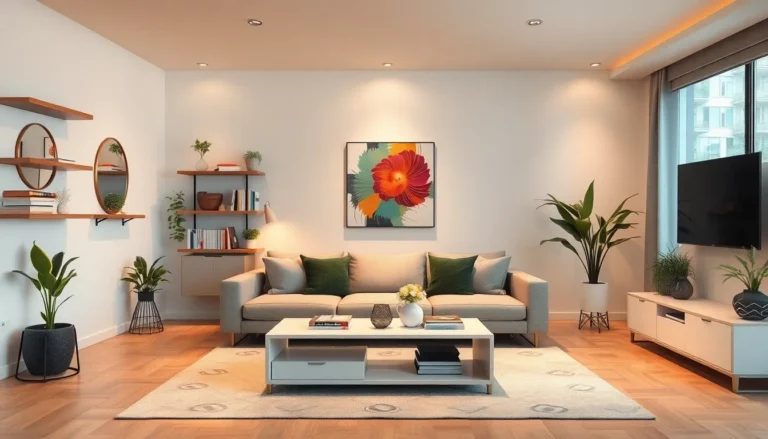Rustic interiors evoke a sense of warmth and charm, drawing inspiration from nature and traditional craftsmanship. This design style embraces raw materials like wood, stone, and metal, creating spaces that feel both inviting and grounded. With its emphasis on simplicity and authenticity, rustic decor has gained popularity among homeowners looking to escape the hustle and bustle of modern life.
Incorporating rustic elements into a home can transform any space into a cozy retreat. From reclaimed barn wood furniture to earthy color palettes, the essence of rustic design lies in its ability to blend comfort with character. Whether it’s a cabin in the woods or a city apartment, rustic interiors offer a timeless appeal that resonates with those who appreciate the beauty of the natural world.
Table of Contents
ToggleOverview of Rustic Interiors
Rustic interiors embody warmth and simplicity, emphasizing natural materials and handcrafted details. They feature elements like exposed beams, rough-hewn woods, and stone accents that create an authentic atmosphere.
Key Characteristics of Rustic Interiors
- Natural Materials: Wood, stone, and metal dominate the design, offering durability and aesthetic appeal through textures and tones.
- Neutral Color Palettes: Earth tones, such as browns, greens, and grays, contribute to a calming environment that connects with nature.
- Traditional Craftsmanship: Handcrafted furniture and decor pieces, often sourced locally or vintage, enhance the personalized feel of the space.
- Cozy Furnishings: Soft textiles, like wool and linen, add comfort to the space while maintaining an organic look.
- Nature-Inspired Decor: Incorporating plants, natural motifs, and rustic artwork reinforces the connection to the outdoors.
Popular Styles Within Rustic Interiors
- Country Style: This style highlights homely comfort with plaid patterns, wooden furniture, and charming accents.
- Log Cabin Style: Common in rural settings, this design utilizes logs for structural elements, creating a strong link to the natural landscape.
- Industrial Rustic Style: Combining industrial elements such as metal with rustic features results in a modern yet cozy feel, popular in urban environments.
- Modern Farmhouse Style: This blend of contemporary and rustic traits includes open spaces, large dining tables, and vintage lighting fixtures.
Rustic interiors foster a sense of peace and escape, appealing to individuals looking for comfort in their living spaces. By incorporating these elements, homeowners can create an inviting atmosphere that resonates with simplicity and authenticity.
Key Characteristics of Rustic Interiors

Rustic interiors are defined by their use of natural materials and warm color palettes, which together create inviting and authentic living spaces. The following characteristics outline the essence of rustic design.
Natural Materials
Natural materials play a vital role in rustic interiors. Wood serves as the foundation for floors, beams, and furniture, bringing a sense of warmth and durability. Stone enhances aesthetic appeal, often used for fireplaces or accent walls, grounding the space in nature. Metal fixtures, such as wrought iron or copper, add character, emphasizing handcrafted details. These materials not only evoke a connection to the outdoors but also ensure longevity.
Warm Color Palettes
Warm color palettes dominate rustic interiors, creating a soothing atmosphere. Earthy tones like browns, tans, and greens reflect natural landscapes, fostering tranquility. Accent colors may include deep reds or rich oranges, which invoke a cozy ambiance. Neutrals complement these warm shades, allowing for versatile combinations that maintain a unified look. This combination of colors enhances the inviting feel of rustic spaces, encouraging relaxation and comfort.
Popular Rustic Interior Styles
Rustic interior styles showcase the beauty of natural materials and traditional craftsmanship. Several specific styles embody the essence of rustic design, each with unique characteristics that enhance warmth and charm.
Farmhouse Style
Farmhouse style emphasizes practicality and simplicity, merging traditional with modern aesthetics. Key features include reclaimed wood for flooring and furniture, open shelving, and apron-front sinks. Neutral color schemes dominate, often accented with shades of white, gray, and soft pastels. Vintage accessories, like mason jars and farm tools, contribute to the appeal. Cozy textiles such as linen and cotton further enhance comfort, creating inviting spaces perfect for family gatherings.
Log Cabin Aesthetics
Log cabin aesthetics focus on rustic charm while making nature a central theme. A signature element involves exposed log walls, which provide warmth and character. Stone elements, including fireplaces and accent walls, complement wooden beams. Earthy tones of browns, greens, and ochres enhance the natural vibe. Furnishings often include oversized, comfortable pieces with soft fabrics, promoting relaxation. Nature-inspired decor, such as animal motifs and handcrafted items, reinforces the log cabin’s connection to the outdoors.
Incorporating Rustic Interiors in Your Home
Incorporating rustic interiors enhances warmth and character in living spaces. This section outlines key aspects to consider for a successful integration of this style.
Choosing the Right Materials
Selecting the right materials forms the foundation of rustic interiors. Wood ranks as the primary material, featuring finishes like reclaimed barn wood, which adds texture and history. Stone complements wood by introducing natural elements, often seen in fireplaces or accent walls. Metal accents, such as wrought iron or aged bronze, contribute a rugged charm, particularly in light fixtures or furniture. Sustainable materials promote an eco-friendly approach, appealing to environmentally conscious homeowners. Opting for locally sourced or vintage items reinforces authenticity while building a connection to craftsmanship.
Essential Decor Elements
Essential decor elements play a vital role in achieving a cohesive rustic look. Textiles such as wool or linen introduce comfort through blankets, rugs, and cushions. Neutral and earthy tones dominate color schemes, inviting relaxation into spaces. Furniture features understated lines and organic shapes, often incorporating antique pieces or custom designs. Nature-inspired decor, including botanical prints or wooden sculptures, reinforces the connection to the outdoors. Artwork made from natural materials or depicting rustic landscapes enhances the charm. Incorporating these elements creates inviting environments that embody rustic aesthetics while maintaining functionality.
Benefits of Rustic Interiors
Rustic interiors offer numerous advantages that enhance living spaces.
- Warmth and Comfort: Rustic design creates inviting environments through cozy textiles and natural materials. Soft furnishings in warm colors foster a snug atmosphere.
- Connection to Nature: Incorporating elements like wood and stone establishes a strong link to the outdoors. Natural materials evoke feelings of tranquility and peace.
- Timeless Appeal: Rustic aesthetics remain in style, blending seamlessly with modern trends. Their classic charm ensures lasting relevance.
- Sustainability: Rustic design often utilizes reclaimed materials, supporting eco-friendly practices. Homeowners can prioritize sustainability while enhancing aesthetics.
- Unique Character: Each rustic space possesses distinct features due to handmade and vintage items. This individuality adds charm and personality to the home.
- Versatility: Rustic interiors adapt well to various design styles. Whether in a cabin or city apartment, they retain their warm, inviting essence.
- Ease of Maintenance: Durable materials like stone and wood resist wear, leading to lower upkeep costs over time. This practicality appeals to numerous homeowners.
These benefits highlight the inviting nature of rustic interiors, making them an appealing choice for many individuals seeking comfort and authenticity in their homes.
Rustic interiors offer a unique blend of warmth and authenticity that resonates with many homeowners. By embracing natural materials and traditional craftsmanship, these spaces create inviting atmospheres that foster comfort and connection to nature. The versatility of rustic design allows it to adapt seamlessly to various styles and settings, making it a timeless choice for both urban and rural dwellings.
Incorporating rustic elements not only enhances aesthetic appeal but also promotes sustainability through the use of reclaimed and vintage materials. As individuals seek refuge from the fast pace of modern life, rustic interiors stand out as a sanctuary of peace and simplicity, inviting everyone to enjoy the beauty of nature within their homes.








